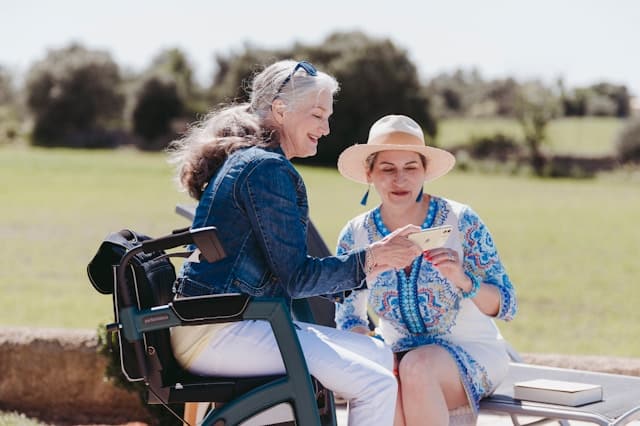Recovering from a stroke can be a long and arduous journey, often requiring sustained therapy and rehabilitation. Traditionally, this process has taken place in hospitals or rehabilitation clinics, but recent advancements in technology have enabled a new approach: home-based tele-rehabilitation. This method of care allows patients to access therapy services from the comfort of their homes using technology.
However, is this approach as effective as traditional, clinic-based rehabilitation? To answer this question, we delve into a review of various studies from reputable sources like Google Scholar, Crossref, and PubMed. This exploration will cover the effectiveness of these interventions in terms of patient recovery and overall health.
Topic to read : How Can Smart Contact Lenses Improve Diabetic Retinopathy Monitoring?
Tele-rehabilitation: A Synthesis of Current Studies
Tele-rehabilitation is an emerging field of study within the healthcare sector, and substantial research has been conducted to evaluate its effectiveness, particularly for stroke patients. When considering the potential benefits, it’s important to base our understanding on validated research and studies.
A systematic review of the studies available on Google Scholar and Crossref indicates that tele-rehabilitation has a potential positive effect on stroke recovery. Many of these studies highlight the increased accessibility and flexibility that home-based rehabilitation can offer, particularly for patients from remote areas or those with mobility issues.
In parallel : How Does Hypobaric Hypoxia Influence Cognitive Function and Brain Health?
By removing the need for regular travel to clinics, patients can focus solely on their recovery and perform their recommended exercises in a familiar and comfortable environment. This aspect plays a considerable role in the patient’s mental wellbeing, which indirectly promotes better recovery.
Evaluating Patient Outcomes and Health Improvements
The effectiveness of therapy and rehabilitation should ideally be reflected in the health improvements and recovery rates of the patients. In this regard, tele-rehabilitation seems to have a promising impact.
Based on various studies available on PubMed, patients who use tele-rehabilitation systems for stroke recovery generally show a comparable or sometimes even better improvement in motor skills and cognitive functions than those who undergo conventional therapy.
One reason for this could be that tele-rehabilitation allows for a more personalized approach to therapy. The use of technology enables therapists to monitor patients’ progress closely and adjust the therapy as per individual needs, which may not always be possible in a traditional rehabilitation setting.
Role of Technology in Home-based Rehabilitation
Technology plays a pivotal role in making home-based rehabilitation possible and effective. The system used for tele-rehabilitation typically includes devices for monitoring patient’s health and progress, video conferencing tools for virtual consultations, and online resources for exercises and therapy.
The technology has been designed to be user-friendly to make it accessible for patients of all age groups. Moreover, the use of digital technology allows for quick and accurate data collection, which aids in tracking progress and making required adjustments in the therapy plan.
Furthermore, the advent of virtual reality (VR) technology has added a new dimension to home-based rehabilitation. The use of VR in stroke rehabilitation has been proven to improve motor skills and cognitive abilities, as demonstrated in several studies.
The Role of Health Care Providers
The role of health care providers in home-based tele-rehabilitation is crucial. They provide the necessary guidance and oversight to ensure that the therapy is carried out correctly and safely.
While technology eases the process, the role of a trained health care provider is irreplaceable. They monitor the patient’s progress, provide feedback, and adjust the therapy plan as necessary. Their expertise and insights form an essential part of the rehabilitation journey.
In addition, health care providers also play a vital role in training patients and their caregivers to use the tele-rehabilitation system effectively. They ensure that the patients understand how to use the equipment and follow the exercises correctly.
Patient Receptiveness and Satisfaction
The effectiveness of a therapy system is also largely dependent on how well it’s received by the patients. In terms of patient satisfaction, home-based tele-rehabilitation seems to score highly.
Patients appreciate the convenience of receiving therapy at home, which eliminates commute and waiting times. The comfort of a familiar environment can also contribute to a positive mindset, which is beneficial for recovery.
In conclusion, while more research is needed for definitive conclusions, existing studies point towards the positive impact of home-based tele-rehabilitation for stroke recovery. It offers a promising alternative to traditional rehabilitation methods, particularly for patients who may find frequent hospital visits challenging.
The Impact of the COVID Pandemic on Tele-rehabilitation
In the face of the COVID-19 pandemic, the need for home-based solutions increased exponentially. The crisis heightened the relevance of tele-rehabilitation systems in providing necessary healthcare services while maintaining safety protocols.
Tele-rehabilitation became more than a convenience; it became a necessity. With lockdown restrictions and fear of virus exposure, stroke patients found it challenging to access traditional rehabilitation services. As per a meta-analysis from various studies available on Google Scholar, tele-rehabilitation emerged as a viable and effective alternative.
This shift not only maintained the continuity of care for stroke survivors but also showcased the potential of tele-rehabilitation to address healthcare challenges beyond the pandemic. This was reflected in an improved health outcome for chronic stroke patients who embraced tele-rehabilitation during this period. Also, the pandemic served as a catalyst for technological innovations in the field, pushing the boundaries of what is possible with tele-rehabilitation.
Future Scope and Challenges of Tele-rehabilitation
The future of tele-rehabilitation looks promising, but it is not without challenges. One of the primary concerns is the digital divide. Not everyone has access to reliable internet, and this can pose a significant barrier for some stroke patients needing tele-rehabilitation.
Another challenge lies in ensuring the quality of therapy. Health care providers must ensure that the quality of care delivered through tele-rehabilitation is at par with traditional methods. This calls for continuous monitoring, regular updates, and improvements in the tele-rehabilitation system.
Moreover, individual insurance plans may not cover tele-rehabilitation, creating a financial burden for patients. Health policy reforms are needed to ensure that tele-rehabilitation becomes a standard part of stroke recovery treatment covered by insurance.
Despite these challenges, the potential benefits of tele-rehabilitation for stroke rehabilitation are significant. With ongoing advancements in technology and a proactive approach to addressing the challenges, tele-rehabilitation can revolutionize the way rehabilitation services are delivered.
Conclusion
The effectiveness of home-based tele-rehabilitation systems for stroke recovery is well-supported by various studies. As demonstrated in a systematic review of research available on platforms like Google Scholar, Crossref, and PubMed, tele-rehabilitation has shown a positive impact on stroke patients.
These benefits include improved accessibility to rehabilitation services, especially for patients in remote locations or those with mobility issues. It also enables a more personalized approach to therapy, which can lead to better health outcomes.
However, the successful implementation of tele-rehabilitation hinges on the role of health care providers and the use of advanced technology. Also, patient receptiveness and satisfaction are key to its effectiveness.
While further research is needed to address the challenges and maximize the potential of tele-rehabilitation, the current evidence points towards its efficacy as a viable alternative to traditional rehabilitation methods. As technology continues to evolve, so too will the potential of home-based tele-rehabilitation. It offers a promising new direction in the field of stroke rehabilitation and opens up exciting possibilities for the future.











